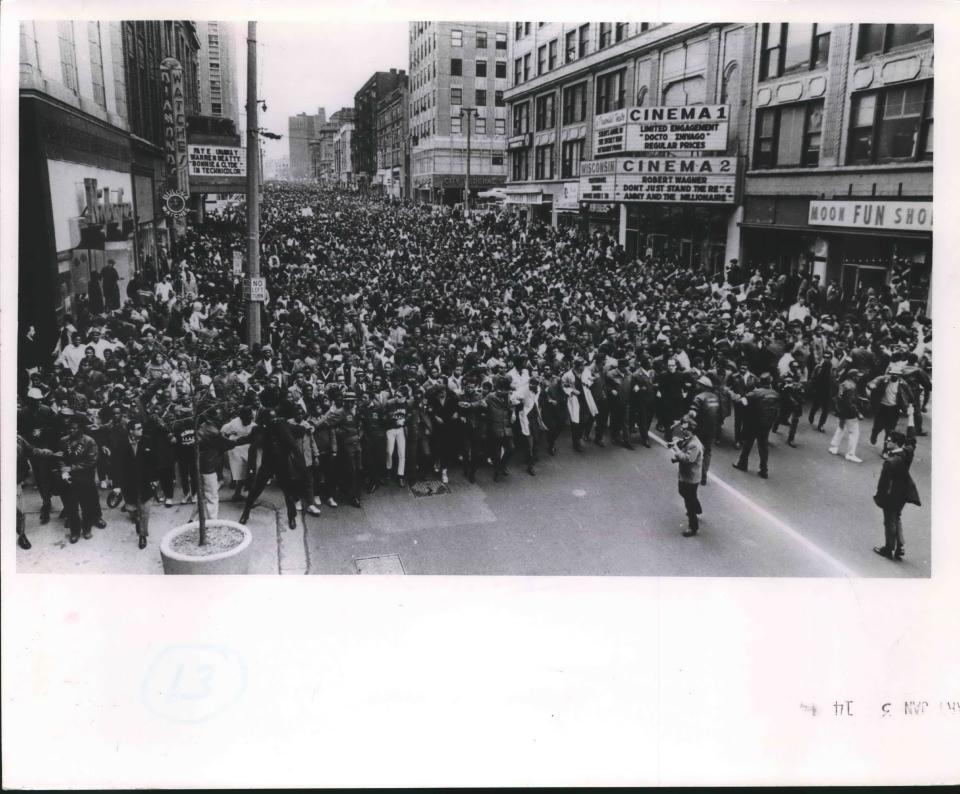Martin Luther King Jr. visited Milwaukee a number of times during his life. He drew thousands of people every time he came.
- Oops!Something went wrong.Please try again later.
Martin Luther King Jr. visited Milwaukee a number of times and his assassination drove around 15,000 people to march on Milwaukee in 1968.
It is believed that King's first speech in Milwaukee happened on Aug. 14, 1957, at the Grand Avenue Congregational Church (now the Irish Cultural & Heritage Center).
The Milwaukee Journal refers to 28-year-old King as "a symbol of the struggle for equal rights." The Journal went on to say that King gave a reasoned but passionate speech.
"If democracy is to live, segregation must die," King told the more than 1,200 attendees.
"We have come a long, long way ... but we have a long, long way to go."
King was in the middle of a political battle with some southern whites who argued for racial segregation. Politicians like Mississippi Sen. James Eastland declared in 1957 that 99% of southern Blacks supported segregation.
"The 50,000 Negroes of Montgomery, Alabama, walked for 381 days and I thought that answered that argument," King told the Milwaukee crowd in response to Eastland's claim.
King, famous for his non-violent stances, urged the crowd to resist segregation even if the price was jail or death. But he said the only way forward is by winning the battles of the minds and souls of those who discriminate.
Martin Luther King Jr. draws crowd to former Milwaukee Auditorium
King returned to Milwaukee on Jan. 27, 1964, just 66 days removed from the John F. Kennedy assassination.
By then King had become a civil rights icon and leader for Black Americans everywhere. He drew more than 6,000 people to his speech at the Milwaukee Auditorium (now the Miller High Life Theatre).
More: Here's where you can learn more about Martin Luther King Jr.'s legacy on MLK Day
Similar to his message in 1957, King urged the crowd to love their "oppressors'."
"Love him with the love of God operating in the human heart," he said.
Vel R. Phillips criticized school board over segregation
Then-Milwaukee Ald. Vel R. Phillips spoke before King and drew a loud applause from the crowd when she criticized the school board because it "has not adopted a clear policy against de facto segregation" in the schools.
King warned against stopping progress.
"We have argued and discussed civil rights enough," he said.
King urged the government to pass federal civil rights legislation.
It was in Milwaukee where King indicated a possibility for a new March on Washington, following the famed march of 1963.
The Milwaukee Sentinel reported that King said he discussed, with civil rights groups, the possibility for a new March on Washington as a "creative protest" rallying for civil rights legislation.
Thousands marched in downtown Milwaukee after King's assassination
The Civil Rights Act of 1964, which prohibits discrimination on the basis of race, color, religion, sex or national origin, was passed in July.
Similar to many communities across the U.S. with significant Black populations, King's followers and supporters grew across the city throughout the mid-1960s.
King's impact was felt in 1968. Following the assassination of King on April 4, 1968, thousands marched on April 8 in Milwaukee.
The Milwaukee Journal wrote an estimated 10,000 to 15,000 people marched in downtown Milwaukee. The march was considered the largest civil rights demonstration in the city's history.

For the most part marchers were silent. Occasionally they sang "We Shall Overcome," the Milwaukee Journal reported.
The Rev. James Groppi spoke at memorial services prior to the march and stressed the importance of remaining non-violent during the demonstration. The marches resulted in some property damage and broken windows.
The crowd was so large at the Groppi speech it was held in a school yard behind the old St. Boniface Church (now near the site of North Division High School).
"Dr. King was a patient man who believed in demonstrations and constructive tension," Groppi told the crowd.
Contact Drake Bentley at (414) 391-5647 or DBentley1@gannett.com. Follow him on Twitter at @DrakeBentleyMJS.
Our subscribers make this reporting possible. Please consider supporting local journalism by subscribing to the Journal Sentinel at jsonline.com/deal.
DOWNLOAD THE APP: Get the latest news, sports and more
This article originally appeared on Milwaukee Journal Sentinel: Martin Luther King Jr. drew thousands in Milwaukee during speeches

